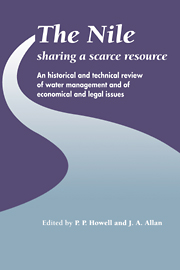 The Nile: Sharing a Scarce Resource
The Nile: Sharing a Scarce Resource Book contents
- Frontmatter
- Contents
- Preface
- List of Contributors
- Orthography
- Units and Conversion Factors
- Introduction
- I Environmental history of the Nile and its management
- II Nile management and factors affecting future management
- III Future utilisation of Nile waters
- IV Economic, international and legal issues
- Index
Preface
Published online by Cambridge University Press: 05 February 2012
- Frontmatter
- Contents
- Preface
- List of Contributors
- Orthography
- Units and Conversion Factors
- Introduction
- I Environmental history of the Nile and its management
- II Nile management and factors affecting future management
- III Future utilisation of Nile waters
- IV Economic, international and legal issues
- Index
Summary
Recent climatic variations and consequent fluctuations in river flows in the Nile Basin suggest that assumptions current in the first half of this century regarding the availability of water may now require drastic readjustment. The mean annual discharge has fallen from 84 cubic kilometres (1900–1959) to 72 cubic kilometres (1977–1987), with an even more dramatic fall in the mean for the years between 1984 and 1987 to less than 52 cubic kilometres.
Historically there have been considerable fluctuations during this century; the annual flow has varied between a maximum of 120 cubic kilometres (1916) and a minimum of 42 cubic kilometres (1984). The Blue Nile, which for most of the century has provided some 86 per cent of the total flow, has shown marked decline in the last few years, with the exception of 1988, following decreases in rainfall over the Ethiopian catchment. On the other hand the White Nile, as the result of exceptionally heavy rainfall over Lake Victoria and most of the East African catchment from the early 1960s, has shown a massive increase in flows over the previous sixty years. These high White Nile flows, especially in the 1960s and early 1970s when flows from the Blue Nile were average or above, have to some extent compensated for the subsequent shortfalls in the Ethiopian tributaries, but inflows from the East African catchment are always masked by the effects of the Sudd swamps.
- Type
- Chapter
- Information
- The Nile: Sharing a Scarce ResourceA Historical and Technical Review of Water Management and of Economical and Legal Issues, pp. ix - xivPublisher: Cambridge University PressPrint publication year: 1994
